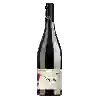
Maison Gilles BoyerCrozes Hermitage
In the mouth this red wine is a powerful with a nice balance between acidity and tannins.
This wine generally goes well with poultry, beef or game (deer, venison).
Taste structure of the Crozes Hermitage from the Maison Gilles Boyer
Light | Bold | |
Smooth | Tannic | |
Dry | Sweet | |
Soft | Acidic |
In the mouth the Crozes Hermitage of Maison Gilles Boyer in the region of Rhone Valley is a powerful with a nice balance between acidity and tannins.
Food and wine pairings with Crozes Hermitage
Pairings that work perfectly with Crozes Hermitage
Original food and wine pairings with Crozes Hermitage
The Crozes Hermitage of Maison Gilles Boyer matches generally quite well with dishes of beef, lamb or game (deer, venison) such as recipes of enchiladas franchouillards, leg of lamb with crust or vermicelli sautéed with peking duck.
Details and technical informations about Maison Gilles Boyer's Crozes Hermitage.
Discover the grape variety: Chinuri
Native to Georgia, it has been known for a long time, especially in the Kartli(e) region in the central part of the country, where it is still grown. It has long been appreciated as a table grape. Chinuri can also be found in Germany, Azerbaijan, Russia, Bulgaria, Slovenia, Romania, sometimes in China, and in France, where it is virtually unknown.
Informations about the Maison Gilles Boyer
The Maison Gilles Boyer is one of of the world's greatest estates. It offers 7 wines for sale in the of Rhône septentrional to come and discover on site or to buy online.
The wine region of Rhône septentrional
Côtes du Rhône is a regional appellation in the Rhône Valley in eastern France. It applies to red, rosé and white wines, and includes more than 170 villages. The area follows the course of the Rhône southward for 125 miles (200 km) from Saint-Cyr-sur-le-Rhône to Avignon. A small portion of the wines in the appellation are white wines.
The wine region of Rhone Valley
The Rhone Valley is a key wine-producing region in Southeastern France. It follows the North-south course of the Rhône for nearly 240 km, from Lyon to the Rhône delta (Bouches-du-Rhône), near the Mediterranean coast. The Length of the valley means that Rhône wines are the product of a wide variety of soil types and mesoclimates. The viticultural areas of the region cover such a distance that there is a widely accepted division between its northern and southern parts.
The word of the wine: Bouchy
See cabernet franc.














